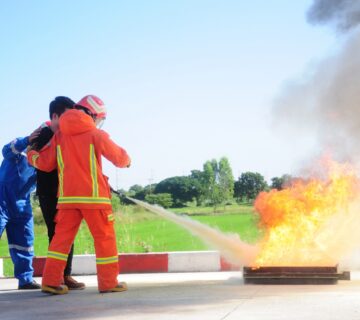From small to large facilities, safety has been a top priority in each environment. One of the safety measures that are not negotiable includes fire safety training. This article seeks to reveal why fire safety training is more than a mere compliance requirement; it is a necessity to save lives and property.
Understanding fire safety training
Fire safety training is important. In other words, the importance of fire safety training will be examined. Fire safety training is a set of curriculum that equips citizens with the capabilities to identify, prevent, and control fire hazards. It requires more than mere use of fire extinguishers; it involves fire dynamics, evacuation plans, and prevention.
Mitigating the Risks: Fire Safety Training: A Review
- Preventing fire incidents
Fire hazards should be prevented as the first line of defense. This training on fire safety helps the employees identify any fire hazards lying around the workplace. For instance, competent persons can prevent fires caused by defective electrical wiring, combustible materials, or improper storage techniques before they occur.
- Efficient Response in Emergency Situations
In the unfortunate case of a fire, it is important to act swiftly and efficiently. Training on fire safety encompasses the skills needed to suppress the first fires. Employees trained in fire safety are in a position to react fast and effectively in order to limit the negative consequences of an emergency situation, from using fire extinguishers to understanding evacuation procedures.
Legal Compliance: Beyond Obligation to Responsibility
- Training requirements related to fire safety
Fire safety training in the workplace is a government requirement for compliance with safety standards. Non-compliance with these rules is punishable by appropriate sanctions and penalties. Consequently, fire safety should be taken seriously, and companies must invest in comprehensive fire safety training as a responsibility to save lives.
- Regular refresher courses
Periodic training updates are a necessity for employees who need to be updated on the most current safety laws. After the initial training, regular refresher courses will help keep workers aware of updated safety procedures.
Protecting lives and assets
- Ensuring employee safety
The main asset of any organization is its people. Fire safety training focuses on employee safety and provides workers with the required information that makes it possible for them to walk through fires safely. This emphasizes employee welfare, which creates a good atmosphere at work, encourages motivation, and leads to high performance.
- Reducing Injury and Fatalities
Statistics show that more than half of workplace injuries and deaths are caused by fire-based incidents. Trained personnel are able to manage emergency situations and, as such, minimize or eliminate the occurrence of injuries or even deaths. In addition, it safeguards the total health of the workforce as a whole.x
Safeguarding property and assets
- Limiting property damage
Fires can lead to death and affect property and assets. Fire safety training courses teach people about ways of containing fire properly, thereby lowering the scope of property destruction. The company’s financial interests are protected, and it also helps with the speed of recovery after a fire has occurred.
- Preserving Critical Business Operations
Business operations can be negatively affected by incidents such as fire, which cause disruptions. Through fire safety training, organizations invest in a resilient workforce that is prepared to minimize the effects of fires. Well-trained employees in emergency response go a long way in minimizing downtime, hence business continuity.
Building a Fire-Resilient Culture
- Creating awareness and responsibility
Fire safety training is more than just teaching technical matters; it creates a safety culture throughout the organization. All employees become aware of fire risks and know that it is their collective responsibility to avoid or minimize the fire and its effects. This collective attitude toward safety penetrates every facet of operations, creating a strong and prepared workplace.
- Empowering every individual
Organizations enable everyone to make a contribution towards creating a safer workplace by giving fire safety training to all levels of staff. Everyone starts to be a stakeholder, from top management to entry-level positions, in ensuring that every employee is safe at work. In essence, this makes the safety program more effective because it is inclusive.
Team building through emergency drills
- Simulating realistic scenarios
A good fire safety training program is not complete without conducting emergency drills. Using simulated natural fire situations helps employees practice what they have learned in an environment that is safe, well-prepared, and realistic. The drills are essential in reinforcing the theoretical knowledge and in developing the coordination and teamwork necessary during real emergency responses.
- Improving response coordination
Coordination during the chaos of the fire emergency leads to a successful response. The employees are trained regularly on the evacuation processes, thereby increasing their cooperation for the proper exit of the employees during emergencies. Such preparedness might help avert future disasters if they occur and also reduce damage from real occurrences.
Cost-Efficiency: A Wise Investment
- Reducing insurance premiums
Organizations with a strong risk management policy are noted by insurers. A commitment to safety is shown by the completion of fire safety training courses, which may result in insurance cost reductions. This financial benefit not only motivates safety practices but also helps to maintain the organization’s total cost-effectiveness.
- Minimizing Losses
Fire incidents have more financial consequences than just the destruction of assets. These losses may come in the form of downtime, legal liabilities, and reputation damage. These risks can be reduced through prevention, which comes in the form of fire safety training, which is very critical in safeguarding an organization’s financial stability.
Conclusion:
Finally, fire safety training should not be just seen as another regulatory requirement. It is an integral part of good business ethics. Such training programs are complex because they have multiple benefits, including legal compliance as well as the preservation of lives and property. The fire safety training course is vital for various reasons in different organizations. Firstly, it is legally compulsory. More importantly, it is a moral and social obligation. They also facilitate the building of stronger and safer societies while avoiding potential legal implications.





